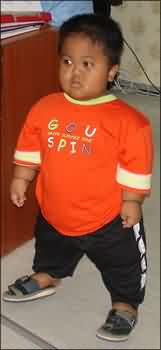What does growth disorder mean?
- A growth disorder implies abnormal growth in infants, children or adolescents which prevents them from achieving their growth expectations.
- Parents may bring their child to see the doctor for being short or small.

Short stature due to achondroplasia
- Growth is a general indicator of a child’s health and well being.
- A child’s growth status can be verified from a standard growth chart. Any deviation from normal needs to be evaluated and the cause determined so that appropriate management can be instituted.
What causes growth disorder?
There are many causes of growth problems in children and they usually fall into the following categories.
Some of these are associated with undergrowth while others with excessive growth.
Familial or genetic short stature: shorter parents tend to have shorter children.
- “Delayed bloomer” (constitutional growth delay with delayed adolescence or delayed maturation) : the child will eventually have a normal final height.
- Any illnesses that affect the whole body (systemic diseases) that is severe, untreated or poorly controlled can have an adverse effect on growth. Examples include :
- Malnutrition
- Digestive tract diseases
- Kidney diseases
- Heart diseases
- Lung diseases
- Haematological disease: e.g. thalassaemia
- Diabetes
- Central nervous system diseases
- Severe stress or emotional trauma
- Endocrine (hormone) diseases
- Lack of thyroid hormones
- Cushing’s syndrome (problem with adrenal hormone production)
- Growth hormone deficiency : failure to produce adequate growth hormone resulting in growth retardation
- Congenital (present at birth) problems in the tissue when growth occurs
- Growth retardation during foetal life
- Chromosome abnormalities: e.g. Turner syndrome
- Skeletal abnormalities (bone diseases or skeletal dysplasias)
- Tall stature
- Unusual tallness in girls
- Early (precocious) puberty : child goes into early puberty
- Genetic conditions: eg. Marfan syndrome
- Idiopathic : No identifiable cause for the growth problem
Signs & symptoms
Some growth problems are immediately diagnosed at birth or noticed at a later age, such as :
- Abnormally small for his age
- Insignificant growth over a one-year period : < 5 cm/year after the second birthday
- Other presenting symptoms and signs will depend on the cause of growth disorder. Consult your doctor for a proper assessment and diagnosis.
What other problems can it cause?
- A child with growth related disorder such as being short or tall faces teasing, criticism and humiliation.
- It can affect a child’s social, academic and economic development.
- Psychological testing on a child is recommended to detect any problem in intelligence, academic achievement, learning disability, attention deficit disorders or behaviour problems.
What treatment is available?
- Treatment of growth problems will depend on the type of growth disorder.
- If an underlying medical condition causes the growth problem, treatment of that condition may solve it. For example, growth failure due to hypothyroidism is treated by a thyroid hormone therapy in a pill form.
- Growth hormone (GH) injections for children with growth hormone deficiency, Turner syndrome, small for gestational age (born small even though it is a term pregnancy) and kidney failure may help them reach a more normal height. Full treatment may take many years and it can be quite costly.
- Develop a positive self-image in your child. Find your child’s strengths and work to build on them.
- Combination of support, counselling and medical treatment will help to produce a better overall outcome.
| Last reviewed | : | 28 August 2020 |
| Writer | : | Dr. Fuziah Md Zain |
| Reviewer | : | Dr. Zainab bt. Kusiar |







